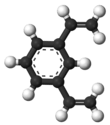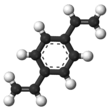Divinylbenzene
.png) | |||
| |||
| Names | |||
|---|---|---|---|
| Other names
Diethylene benzene, DVB, Vinylstyrene | |||
| Identifiers | |||
| ChemSpider | |||
| ECHA InfoCard | 100.013.932 | ||
| EC Number | 215-325-5 | ||
| Properties | |||
| C10H10 | |||
| Molar mass | 130.19 g·mol−1 | ||
| Appearance | pale, straw-colored liquid[1] | ||
| Density | 0.914 g/mL | ||
| Melting point | −66.9 to −52 °C (−88.4 to −61.6 °F; 206.2 to 221.2 K) | ||
| Boiling point | 195 °C (383 °F; 468 K) | ||
| 0.005% (20°C)[1] | |||
| Solubility in other solvents | Soluble in ethanol and ether | ||
| Vapor pressure | 0.7 mmHg (20°C)[1] | ||
| Hazards | |||
| Flash point | 76 °C (169 °F; 349 K) | ||
| Explosive limits | 1.1%-6.2%[1] | ||
| US health exposure limits (NIOSH): | |||
PEL (Permissible) |
none[1] | ||
REL (Recommended) |
TWA 10 ppm (50 mg/m3)[1] | ||
IDLH (Immediate danger) |
N.D.[1] | ||
Except where otherwise noted, data are given for materials in their standard state (at 25 °C [77 °F], 100 kPa). | |||
| Infobox references | |||
Divinylbenzene (DVB) consists of a benzene ring bonded to two vinyl groups. It is related to styrene (vinylbenzene) by the addition of a second vinyl group.[2] It is a colorless liquid manufactured by the thermal dehydrogenation of isomeric diethylbenzenes. Under synthesis conditions, o-divinylbenzene converts to naphthalene and thus is not a component of the usual mixtures of DVB.[3]
Production and use
It is produced by dehydrogenation of diethylbenzene:
- C6H4(C2H5)2 → C6H4(C2H3)2 + 2 H2
Divinylbenzene is usually encountered as a 2:1 mixture of m- and p-divinylbenzene, containing also the corresponding isomers of ethylvinylbenzene.
Styrene and divinylbenzene react to form the copolymer styrene-divinylbenzene, S-DVB or Sty-DVB. The resulting cross-linked polymer is mainly used for the production of ion exchange resin.[3]
Nomenclature
- Ortho: variously known as 1,2-diethenylbenzene, 1,2-divinylbenzene, o-vinylstyrene, o-divinylbenzene
- Meta: known as 1,3-diethenylbenzene, 1,3-divinylbenzene, m-vinylstyrene, m-divinylbenzene
- Para: known as 1,4-diethenylbenzene, 1,4-divinylbenzene, p-vinylstyrene, p-divinylbenzene.
These compounds are systematically called diethenylbenzene, although this nomenclature is rarely encountered.
References
- 1 2 3 4 5 6 7 "NIOSH Pocket Guide to Chemical Hazards #0248". National Institute for Occupational Safety and Health (NIOSH).
- ↑ CRC Handbook of Chemistry and Physics 65Th Ed.
- 1 2 Denis H. James William M. Castor, “Styrene” in Ullmann’s Encyclopedia of Industrial Chemistry, Wiley-VCH, Weinheim, 2005. doi:10.1002/14356007.a25_329.pub2.

